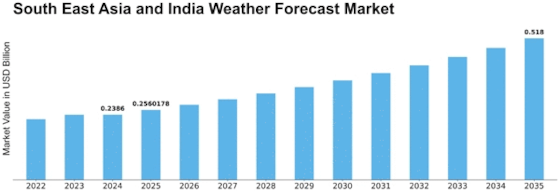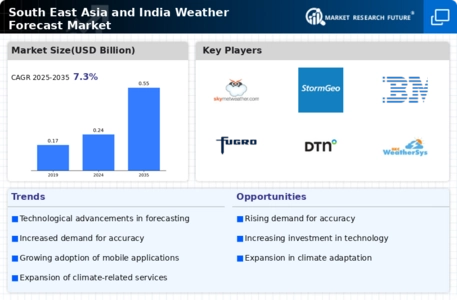South East Asia And India Weather Forecast Size
South East Asia and India Weather Forecast Market Growth Projections and Opportunities
The weather forecast market in South East Asia and India is significantly influenced by various factors that drive its growth and development. One crucial factor is the region's susceptibility to diverse weather patterns, including tropical storms, monsoons, heatwaves, and typhoons, which pose significant challenges for agriculture, infrastructure, transportation, and public safety. As countries in South East Asia and India seek to improve disaster preparedness, resource management, and economic resilience, there is a growing demand for accurate and reliable weather forecasting services to mitigate risks, inform decision-making, and protect lives and property. Weather forecast providers play a vital role in delivering timely and actionable weather information to governments, businesses, emergency responders, and the general public, enabling them to plan and respond effectively to changing weather conditions and extreme events.
Moreover, technological advancements drive market growth and innovation in the South East Asia and India weather forecast market. Advances in meteorological sensors, satellite imaging, radar systems, data analytics, and numerical weather prediction models enable weather forecast providers to improve the accuracy, resolution, and lead time of weather forecasts. This includes the development of high-resolution weather models, ensemble forecasting techniques, and probabilistic forecasts that provide valuable insights into uncertainty and variability in weather predictions. Additionally, the integration of artificial intelligence (AI), machine learning (ML), and big data analytics enhances the capabilities of weather forecasting systems to analyze vast amounts of observational data, atmospheric variables, and historical weather patterns to generate more accurate and personalized forecasts for specific regions, timeframes, and applications.
Furthermore, regulatory frameworks and government initiatives significantly influence market dynamics in the South East Asia and India weather forecast market. Governments in the region play a central role in funding, regulating, and coordinating weather forecasting activities to ensure public safety, national security, and economic resilience. Meteorological agencies and weather forecast providers collaborate closely with government agencies, research institutions, and international organizations to monitor weather conditions, issue timely warnings, and support disaster response and recovery efforts. Additionally, governments invest in infrastructure development, such as weather observation networks, satellite systems, and supercomputing facilities, to enhance the capacity and capabilities of weather forecasting services and improve the accuracy and reliability of weather predictions.
Moreover, market demand for weather forecasting services is driven by factors such as population growth, urbanization, economic development, and climate change. As populations in South East Asia and India continue to grow, urbanize, and migrate to coastal areas, there is an increasing need for weather forecasting services to support urban planning, infrastructure development, and disaster risk reduction initiatives. Additionally, economic activities such as agriculture, aviation, maritime shipping, tourism, and renewable energy are highly sensitive to weather and climate variability, driving demand for weather forecasting services to optimize operations, manage risks, and enhance decision-making. Moreover, climate change impacts, such as rising temperatures, changing rainfall patterns, and more frequent extreme weather events, underscore the importance of accurate and reliable weather forecasts for adapting to climate risks, building climate resilience, and reducing vulnerability in South East Asia and India.
Furthermore, market factors such as technological partnerships, international collaborations, and private sector investments drive innovation and competition in the South East Asia and India weather forecast market. Weather forecast providers collaborate with technology companies, research institutions, and academia to develop and deploy innovative solutions, such as weather apps, mobile platforms, and IoT devices, to deliver personalized and location-based weather forecasts to end-users. Additionally, international collaborations and partnerships with global meteorological organizations, such as the World Meteorological Organization (WMO) and the Asia-Pacific Economic Cooperation (APEC), enable knowledge sharing, capacity building, and best practices exchange to enhance the quality and reliability of weather forecasting services in the region. Moreover, private sector investments from weather forecast providers, media companies, telecommunications operators, and e-commerce platforms drive market competition and innovation in the development and delivery of weather forecasting products and services tailored to specific user needs and preferences.


















Leave a Comment